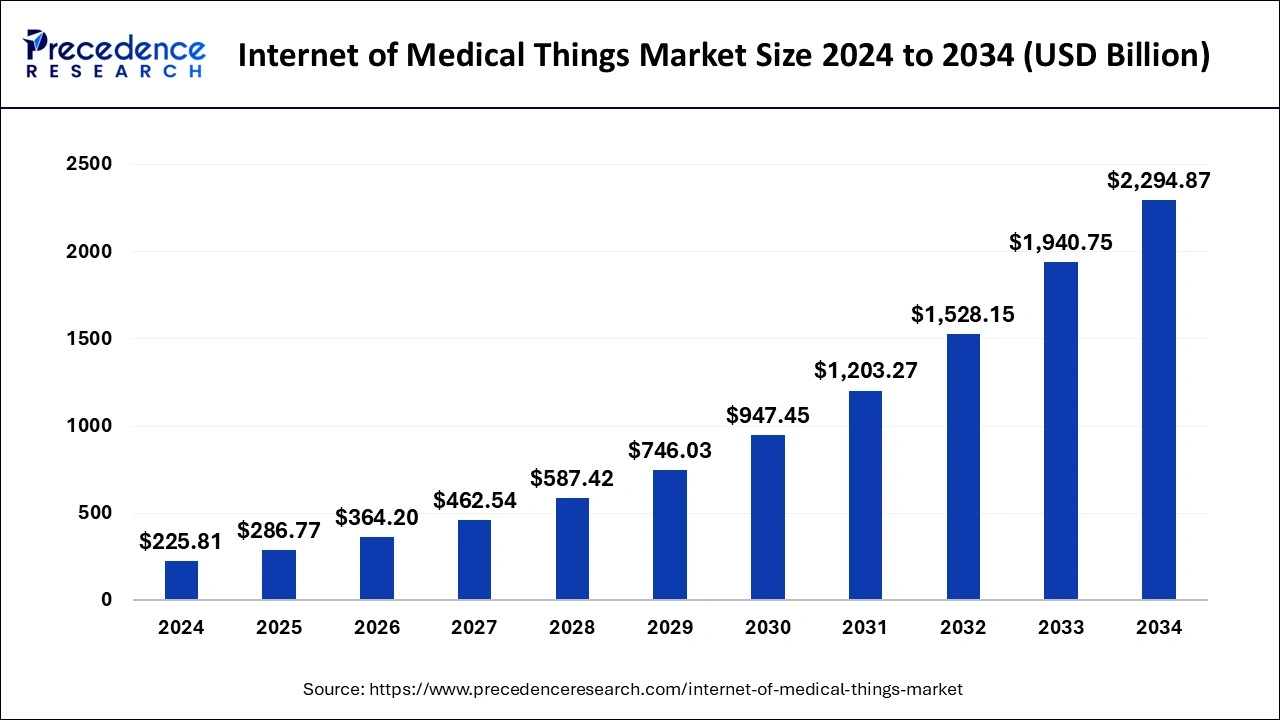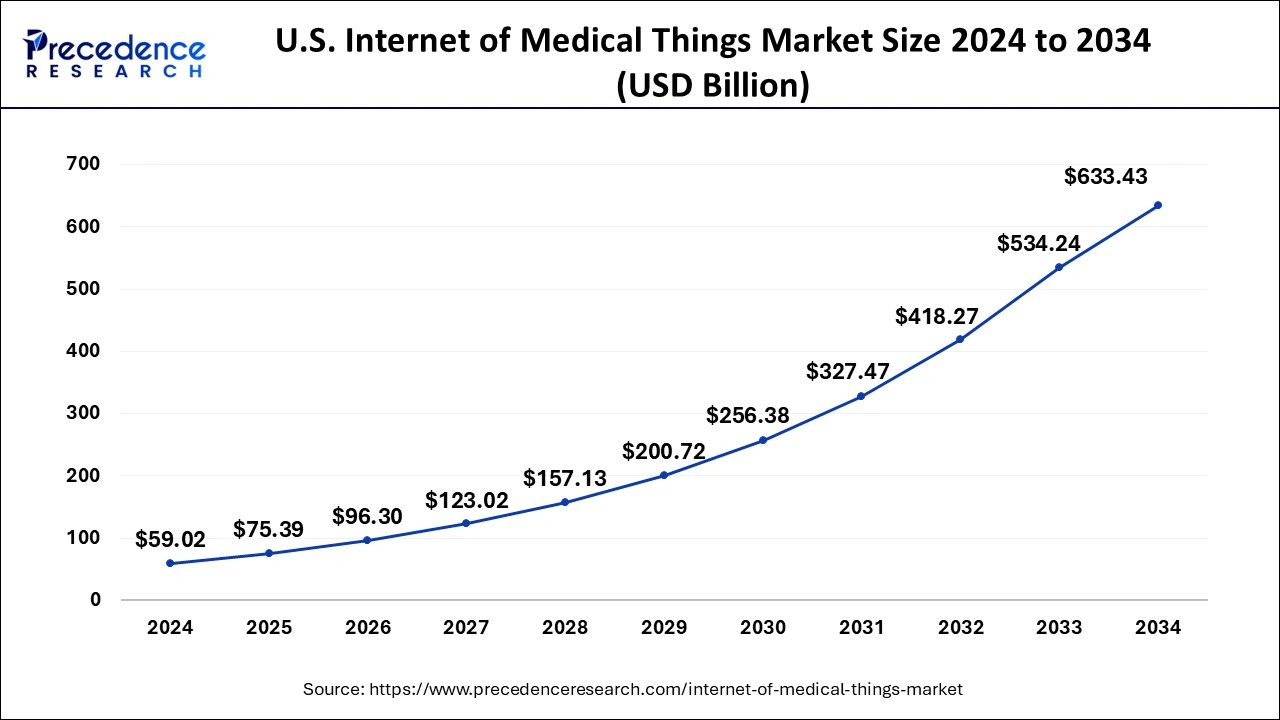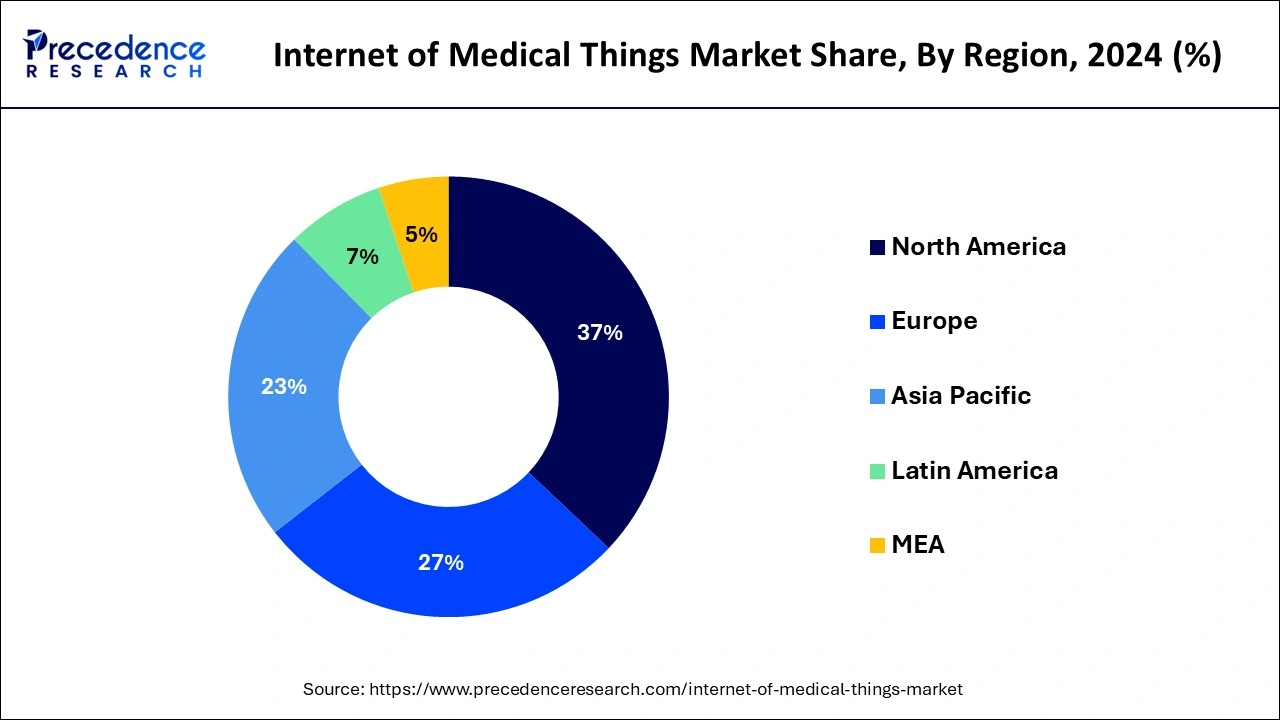List of Contents
Internet of Medical Things Market Size and Forecast 2025 to 2034
The global internet of medical things (IoMT) market accounted for USD 225.81 billion in 2024 and is expected to exceed around USD 2,294.87 billion by 2034, growing at a CAGR of 26.09% from 2025 to 2034.

Internet of Medical Things Market Key Takeaways
- North America led the global market with the highest market share of 37.05% in 2024.
- By product type, the smart wearable segment has held the largest market share of 25% in 2024.
- By product type, the point of care kits segment is expected to grow at a remarkable CAGR during the forecast period.
- By end user, the hospitals & clinics segment captured the biggest revenue share in 2024.
- By end user, the homecare segment is expected to expand at the fastest CAGR over the projected period.
- By application, the telemedicine segment registered the maximum market share in 2024.
How has AI benefited the market?
The Internet of Medical Things (IoMT), when enhanced with Artificial Intelligence, has, undoubtedly, made diagnostic interventions, therapies, and management services shine brighter in the world of healthcare. AI algorithms analyze larger data sets generated via connected medical devices and detect minuscule patterns and anomalies to diagnose at the earliest possible onset and permit intervention. These algorithms may also interrogate patient mounds of information-from the genetic level to lifestyle information to real-time monitoring-for the purpose of establishing individualized treatment plans. Similarly, AI-powered IoMT applications optimize the workflow through the automation of mundane tasks, ensure the best resource allocation, and minimize hospital-dependent visits through remote monitoring. These systems offer continuous monitoring for chronic patients and recovering outpatients. Tracking health status and managing medications are then possibilities patients can undertake with AI-enabled supports, which boost treatment compliance and encourage healthy behaviors.
U.S. Internet of Medical Things Market Size and Growth 2025 to 2034
The U.S. internet of medical things (IoMT) market size size was exhibited at USD 1.64 billion in 2024 and is projected to be worth around USD 3.97 billion by 2034, growing at a CAGR of 9.24% from 2025 to 2034.

Based on region, North America dominated the global internet of medical things market in 2024, in terms of revenue and is estimated to sustain its dominance during the forecast period. North America is characterized by the strong and developed healthcare infrastructure, improved IT infrastructure, developed telecommunications, and increased penetration of internet. Further, rising consumer expenditure on health care, increased disposable income, and rising prevalence of diseases are the certain factors that has boosted the market growth in this region.

On the other hand, Asia Pacific is estimated to be the fastest-growing market during the forecast period. This is attributable to the rising disposable income of the consumers, rising health consciousness, rising government initiatives to develop IT infrastructure, and increased investments on digitalizing healthcare sector are the major drivers of the Asia Pacific internet of medical things market.
Internet of Medical Things Market Growth Factors
The increased adoption of the information technology in the healthcare sector and rapid technological developments in it have significantly boosted the growth of the global internet of medical thigs market. The internet of medical things helps to connect various medical devices to each other through internet connectivity. The surging popularity of 5G technology and rising investments in the development of sophisticated 5G networks across the globe is expected to drive the growth and adoption of the internet of medical thing across the healthcare units and households. The most effective feature of the IoMT is that it transfers and shares data related to the health of the patient without any human to machine interaction. The various IoMT devices like smart wearables have emerged as an effective technology that facilitates remote monitoring and diagnosis of the patients' health. All these factors are expected to drive the demand for the internet of medical things among the various end users all over the globe.
Furthermore, the rising developmental strategies adopted by the key market players are anticipated to open new growth avenues and provide lucrative opportunities in the upcoming future. For instance, CONNEQT and LifeQ entered into a partnership in June 2021, for providing health related information to the wearable device users. Further, the recent outbreak of the COVID-19 pandemic has acted as a catalyst to the adoption of the digital technologies across all the industries including healthcare industry. The pandemic led the digital transformation in the healthcare industry at a rapid rate and this is expected to have a very long-term effect that may change the face of the entire healthcare industry in the upcoming future. Further, the increased government efforts and private investments are propelling the adoption rate of digital technologies in the healthcare sector to tackle the pandemic situation in the future. All these factors are expected boost the growth of the global internet of medical things market.
- Growing adoption of IT in healthcare and rapid technological developments have been driving the IoMT market growth.
- Expansion of 5G networks is enhancing connectivity between medical devices within hospitals and in residential buildings.
- Increasing use of IoMT devices such as smart wearables to study and diagnose without requiring a human to interface with machines.
- Key market participants are entering into strategic partnerships and investments to carve out new avenues for growth.
- The rising government initiatives, along with private sector funding for the adoption of IoMT in healthcare, are accelerating.
Market Scope
| Report Coverage | Details |
| Market Size in 2025 | USD 286.77 Billion |
| Market Size by 2034 | USD 2,294.87 Billion |
| Market Growth Rate from 2025 to 2034 | CAGR of 26.09% |
| Largest Market | North America |
| Fastest Growing Market | Asia Pacific |
| Base Year | 2024 |
| Forecast Period | 2025 to 2034 |
| Segments Covered | By Product Type, By End User, and By Application |
| Regions Covered | North America, Europe, Asia-Pacific, Latin America, and Middle East & Africa |
Drivers
Increasing Demand for RPM
With the aid of IoMT, RPM enables continuous health data collection and transmission outside of clinical setups for managing chronic diseases and care of aged persons. It reduces hospital readmissions and improves patient outcomes, thereby availing a cheaper mode of healthcare delivery. Since patients are monitored in real time, this ensures timely interventions, convenience for the patient, and less strain on the hospital.
Opportunity
Smart Hospitals and Connected Medical Equipment
The IoMT is moving more toward smart hospitals with the connected infrastructure comprising automated beds, intelligent infusion pumps, and real-time asset tracking. Integration with and Electronic Health Record (EHR) enables smoother workflow, patient safety, and operational efficiency. These developments allow for flawless data communication, efficient resource management, and a patient-centric approach- essentially making the hospital operationally efficient.
Restraint
Data Security and Privacy
As patient data handled by IoMT devices is sensitive, the devices can become the very crux for cyberattacks and data breaches. Illegal disclosure can kill patient safety and trust. No uniform security standards makes their implementation difficult. Compliance with security regulations like the HIPAA (US) or GDPR (EU) is mandatory. Strong encryption methods, proper authentication, and secure means of data transmission are essential to maintaining a decent level of integrity for personal health information.
Product Type Insights
Based on product type, the smart wearable segment accounted for more than 25% of the market share in 2024 and is estimated to sustain its dominance during the forecast period. Smart wearable devices includes bands, activity trackers, smart garments, and sports watch. All these digital and medical devices are gaining rapid traction among the consumers owing to the rising health consciousness and rising consumer expenditure of health and wellness products. Furthermore, the development of clinical grade wearables is getting rapid traction. For instance, Neurometrix developed a neuromodulation wearable device named Quell, which provides relief from various chronic pains by tapping into the sensory nerves. Therefore, these technologically advanced product developments are expected to drive the growth of this segment further.
The point of care kits segment is expected to be the most opportunistic segment during the forecast period. This owing to the rising hospital admissions and rising number of patients visits to the clinics and hospitals.According to the CDC, in 2019, there were 45 million outpatient surgeries, over 900 million physician visits, and 155 million emergency department visits in US. Hence, the rising use of point of care kits is boosting the growth of this segment.
End User Insights
Based on end user, the hospitals & clinics segment dominated the global internet of medical things market in 2024, in terms of revenue and is anticipated to sustain its dominance during the forecast period. This can be attributed to the rising prevalence of chronic diseases, growing geriatric population, and rising healthcare expenditure among the consumers. The growing need for regular health check -ups and increasing demand for the smart technologies for tracking patients' health conditions in the hospitals and clinics has boosted the growth of this segment in the past few years.
On the other hand, the homecare segment is expected to be the fastest growing segment during the forecast period. This can be attributed to the increased preferences on the consumers in the developed nation to get treatment for various diseases at their homes. Increased disposable income, increased awareness regarding hospital acquired infections, and increased consumer expenditure of health and wellness products and services are the various factors that may foster the growth of this segment during the forecast period.
Application Insights
Based on application, the telemedicine segment accounted largest revenue share in 2024 and is estimated to sustain its dominance during the forecast period. This can be attributed to the rapid growth and development of the telemedicine industry across the globe. The telemedicine emerged as a result of the technological advancements in the digital technology field and has been increasingly adopted across the various healthcare units around the globe. The real-time data sharing and effective communication owing to the use of telemedicine is changing the face of the healthcare industry by improving the efficiency of the healthcare sector in patient care.
On the other hand, patient monitoring segment is expected to be the fastest-growing segment owing to the rising prevalence of diseases among the population and growing geriatric population. The need for monitoring cancer patients and old age people is continuously rising and so is the adoption of the patient monitoring system. Hence, this segment is estimated to grow rapidly in the upcoming years.
Key Companies & Market Share Insights
The market is moderately fragmented with the presence of several local companies. These market players are striving to gain higher market share by adopting strategies, such as investments, partnerships, and acquisitions & mergers. Companies are also spending on the development of improved products. Moreover, they are also focusing on maintaining competitive pricing.
In June 2021,CONNEQT and LifeQ entered into a partnership for providing health related information to the wearable device users.
The various developmental strategies like partnerships and product launches fosters market growth and offers lucrative growth opportunities to the market players.
Internet of Medical Things Market Companies
- GE healthcare
- Koninklijke Philips N.V.
- Medtronic MiniMed, Inc.
- LifeFuels, Inc.
- Meru Health, Inc.
- Breathometer Inc.
- Carre Technologies Inc.
- Apple, Inc.
- Honeywell International, Inc.
- IBM Corp.
- Wimm Labs
- Sony
- Nike
- Amiigo
- Sano Intelligence
- iRhythm
- Hexoskin
Segments Covered in the Report
By Product Type
- Smart Wearables
- Point of Care Kits
- Home Use Devices
By End User
- Hospitals & Clinics
- Home Care
- Research Institutes
By Application
- Telemedicine
- Patient Monitoring
- Medication Management
- Others
By Region
- North America
- Europe
- Asia-Pacific
- Latin America
- Middle East and Africa
For inquiries regarding discounts, bulk purchases, or customization requests, please contact us at sales@precedenceresearch.com
Frequently Asked Questions
Ask For Sample
No cookie-cutter, only authentic analysis – take the 1st step to become a Precedence Research client